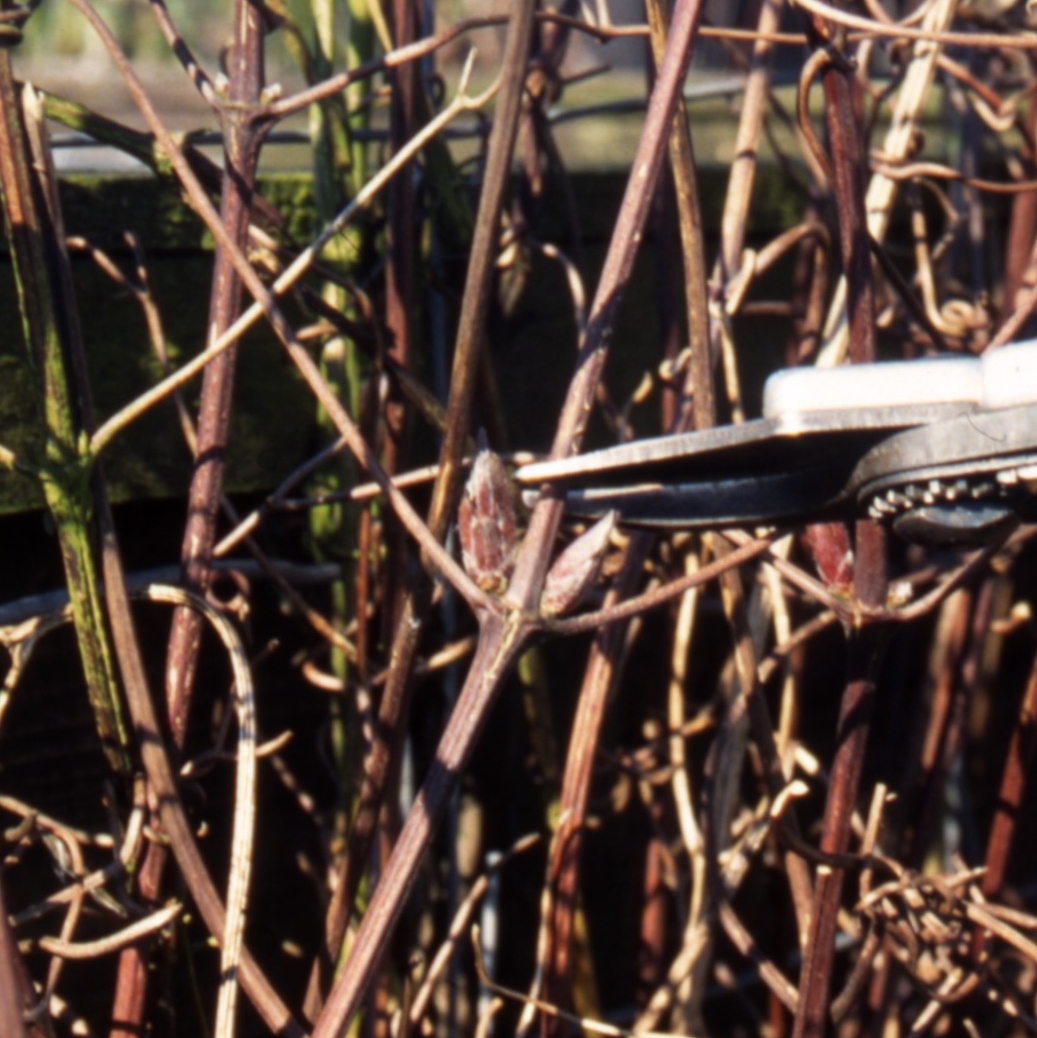How To Prune Clematis
How to Prune Clematis
Do not be afraid of pruning! You will not kill your clematis if you get it wrong, the flowers might come out late but that's about the worst that can happen.
When pruning clematis, secateurs can be rather cumbersome and their thin stems get caught in the blades which can cause the stems to get 'tugged' and damaged lower down. We have always preferred to use sharp scissors like our Barnel Clematis Pruning Scissors which are light weight and ideal for this more intricate pruning work that clematis require.
How to Prune Young Clematis
We strongly recommend that you hard prune all clematis sometime within the first year of planting for the following reasons.
1. It will encourage your clematis to put its roots out and form a strong root system.
2. It will encourage new shoots to form in the leaf axils below soil level, which were buried when planted. The more stems you have on your clematis, the more flowers you will get!
3. It will reduce the amount of foliage the young root system has to sustain.
Many nurseries will tell you to prune immediately after planting but this often means loosing flowers or the potential for flower. We recommend the following:
For Tidy Prune (Group 1) a hard prune should be carried out immediately after the first year’s flowering has finished.
For Light Prune (Group 2) a hard prune should be carried out during February or March the first year after planting.
For Hard Prune (Group 3) a hard pruned is carried out every February / March anyway.
After the first year simply follow the pruning method for established clematis below.
Demystifying Clematis Pruning.
The following image is a slide I produced for lectures and I hope it helps to clarify WHY we prune in the way we do. The pruning type is dictated by the time of year the plant flowers.
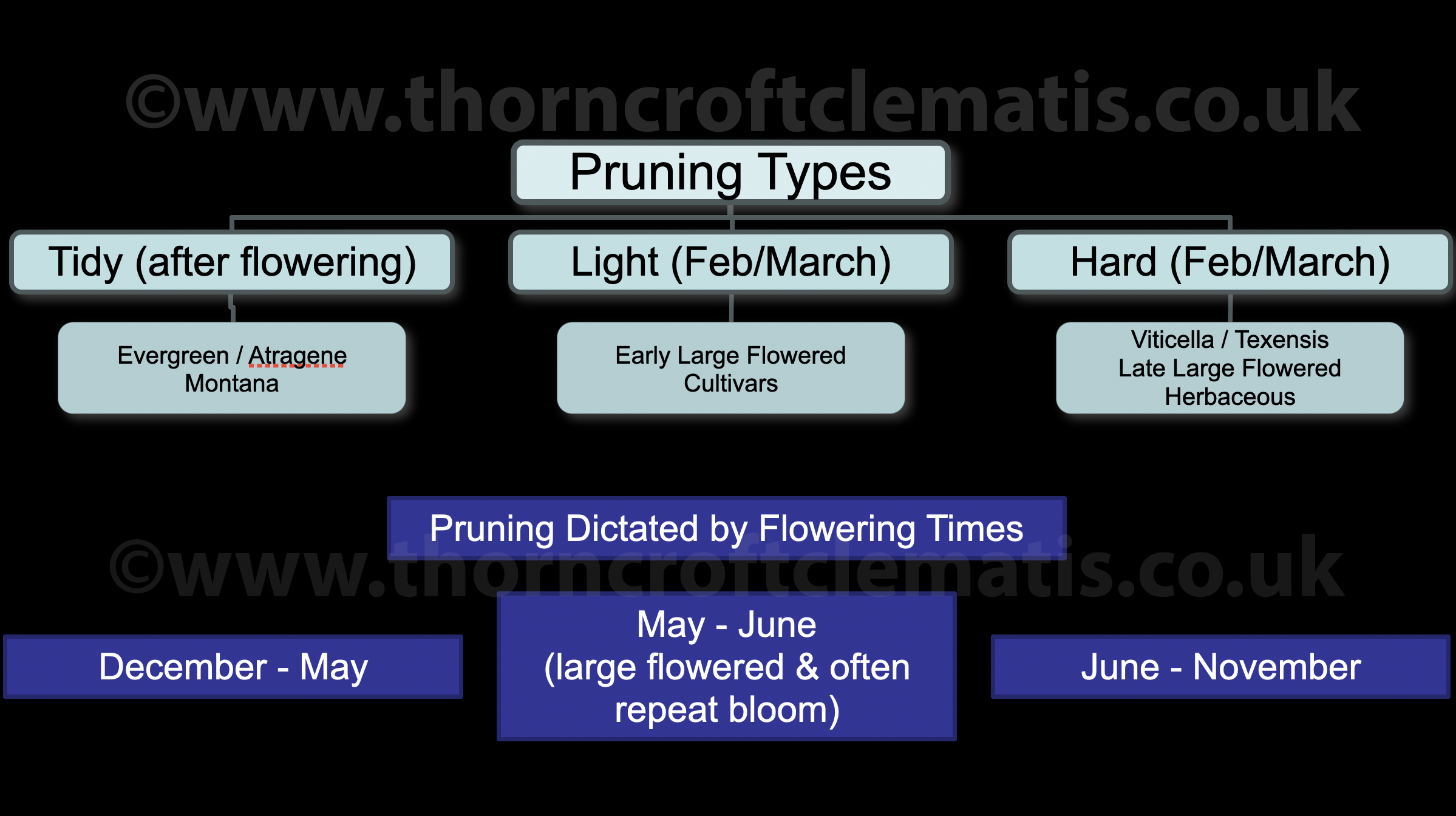
How to Prune Established Clematis
Tidy after flowering - Pruning Group 1
This includes the groups Armandii, Atragene, Cirrhosa, Forsteri, Montana Groups & other Evergreen clematis.
Following the initial hard prune, described above for the first year, these cultivars simply need a good ‘tidy up’ each year immediately after flowering has finished. Prune off unwanted growth then tie the remainder to its support.
If you wish to keep them more compact, light prune after flowering (see Light Pruning below). This will prevent the montana's from getting out of control and will help prevent others from getting a woody structure at the base. Sometimes it can cause them not to flower as well, in which case you may have to stop pruning like this and only tidy them.
Light Pruning - Pruning Group 2
This is for the Early Large Flowered Cultivars of clematis.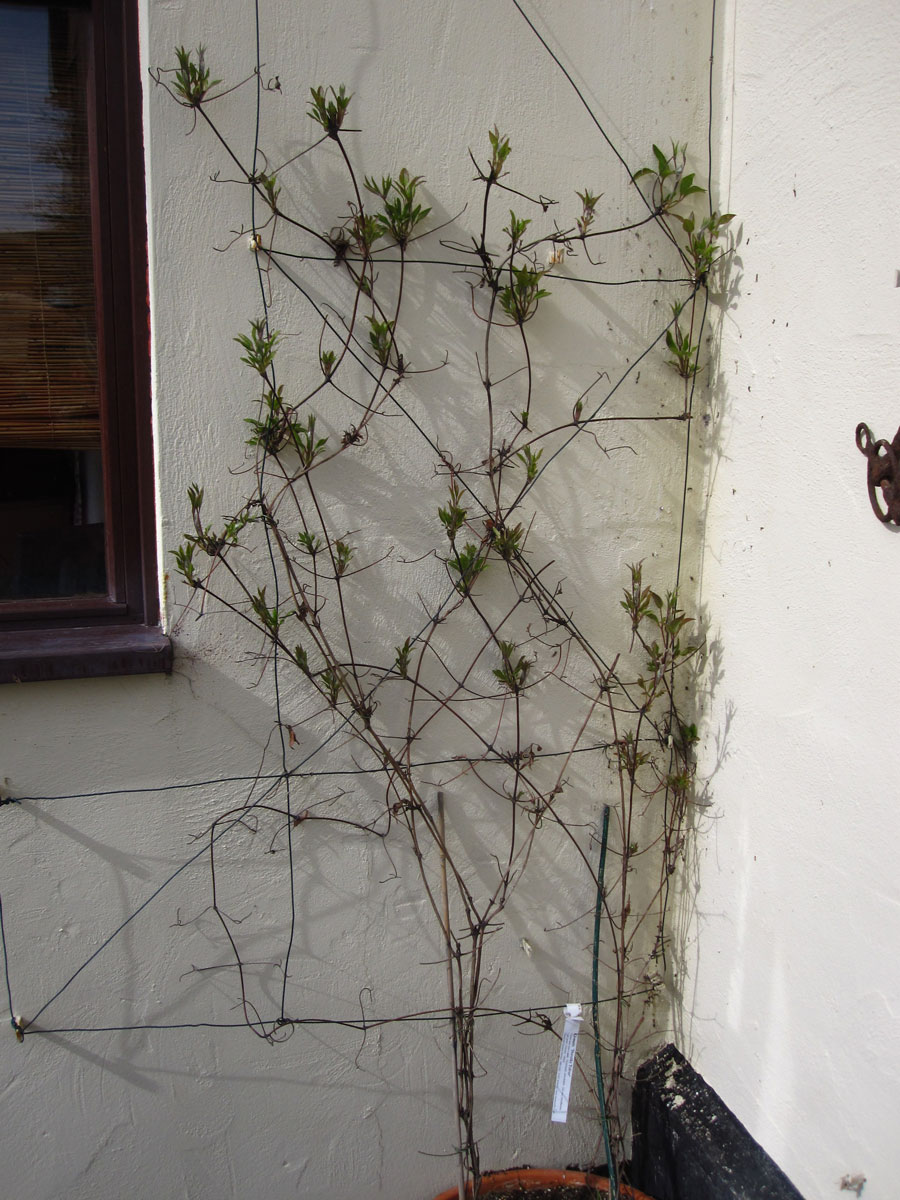
Following the initial hard prune described above for the first year, light pruning should be carried out during late February or March each year.
Start at the top of the plant and reduce all stems down by about one third, to remove the 'birds nest' from the top.
Prune the remaining stems working from the top downwards looking for viable buds or shoots as in the picture to the right. These shoots may be apparent at differing heights on each stem, some as low as 6” (15cm) from the soil level and that is fine because new growth will then come at all different heights and this will help to keep the plant flowering all the way up and generally look much neater.
A complete hard prune every few years will help to rejuvenate an old, tired plant if necessary. When carrying this out we would recommend partially pruning the clematis to between thigh and waist height during late autumn or early winter. This will help the plant re-shoot low down in late winter / early spring.
Dead-Heading Clematis
Clematis from light prune group benefit from dead-heading after the early flowers have finished. Apply liquid tomato feed as recommended on our Feeding & Plant Health page, which will encourage new flowering growth to form and another good display of blooms can be enjoyed in late summer and early autumn.
I hope I can clarify this for you and make life easier, it can be made terribly difficult with so much conflicting advice out there.
I tend to deadhead anything with a large or open flat flower which blooms before July. The reason is these will often flower again from new growth made during the early summer months.
The early flowering macropetela, alpina, montana and evergreens all flower very freely and are not going to re-bloom so there is no need to deadhead.
Then the late flowering types like viticella, texensis and late large flowered hybrids, all flower strongly without dead-heading being necessary.
So when considering dead-heading, primarily think of the early (May-June) and largest flowering clematis because they put a lot of effort into their extravagant, large flowers and therefore benefit the most from the dead-heads being removed, allowing them to put the energy that might have gone into the seed-heads, into more late flowers.
The patio clematis by Raymond Evison do also benefit from dead-heading because they've been hybridised many times meaning they lack some of the natural vigour of other clematis, therefore they also benefit from dead-heading to stop them becoming exhausted and encouraging them to continue to flower longer.
All others can be ignored.
Hard Pruning - Pruning Group 3 Clematis
This includes the Late Large Flowered Cultivars, Flammula, Florida, Tangutica, Texensis and Viticella Groups.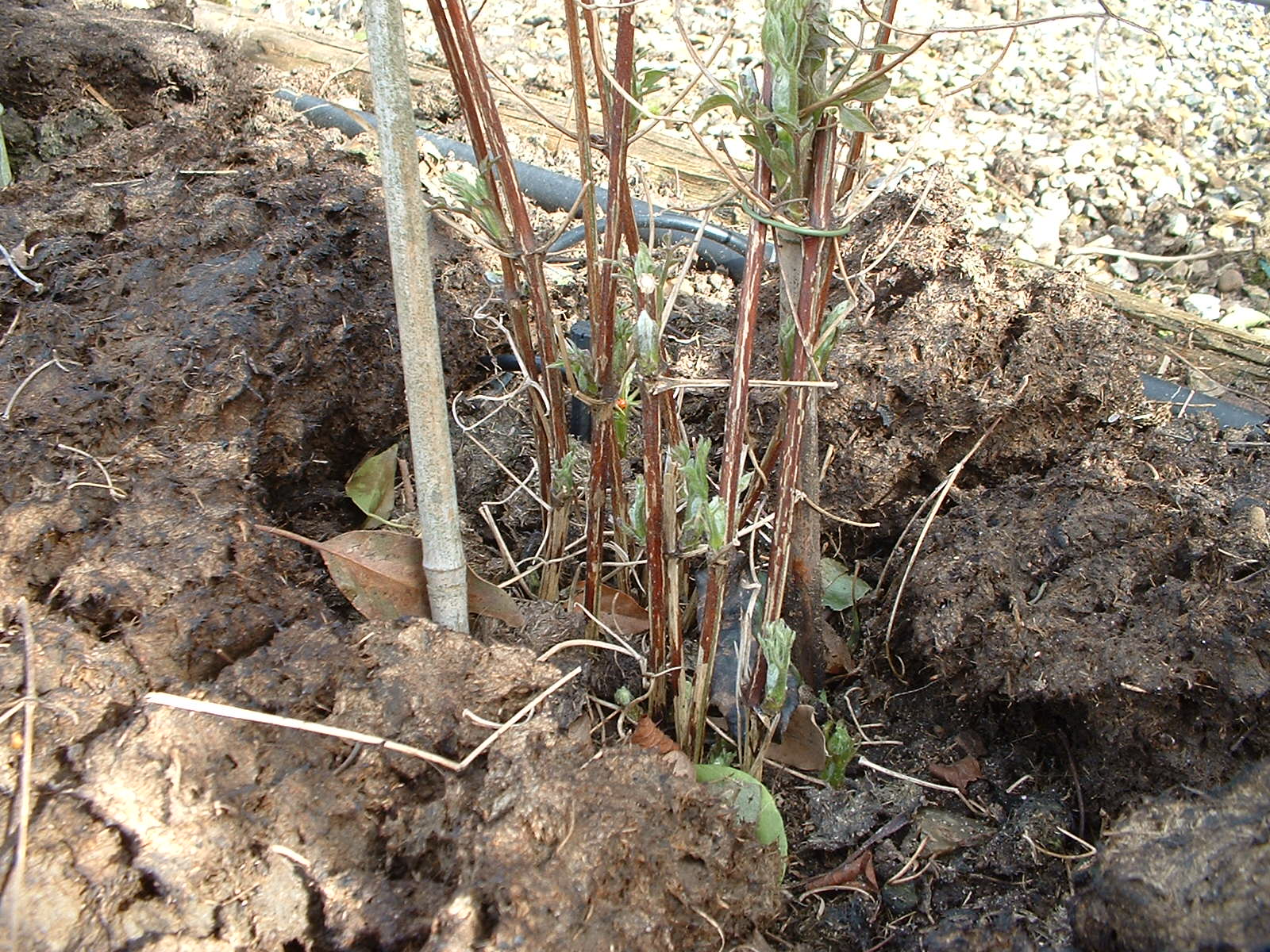
Hard pruning is normally carried out during late February or March. Prune all growth back to a good set of viable buds in the leaf joints, approx. 6"- 18"(15-45cm) from soil level. If you prefer to tidy your clematis in late autumn or early winter, partial hard pruning can be carried out then. Roughly prune to 18"(45cm) and tie the remaining stems to prevent damage in a windy situation. Then in late winter or early spring a full hard prune can be carried out. It is always safer to leave a bit of extra growth on the clematis over the winter period and not prune too hard too soon.
How to Prune Herbaceous Clematis
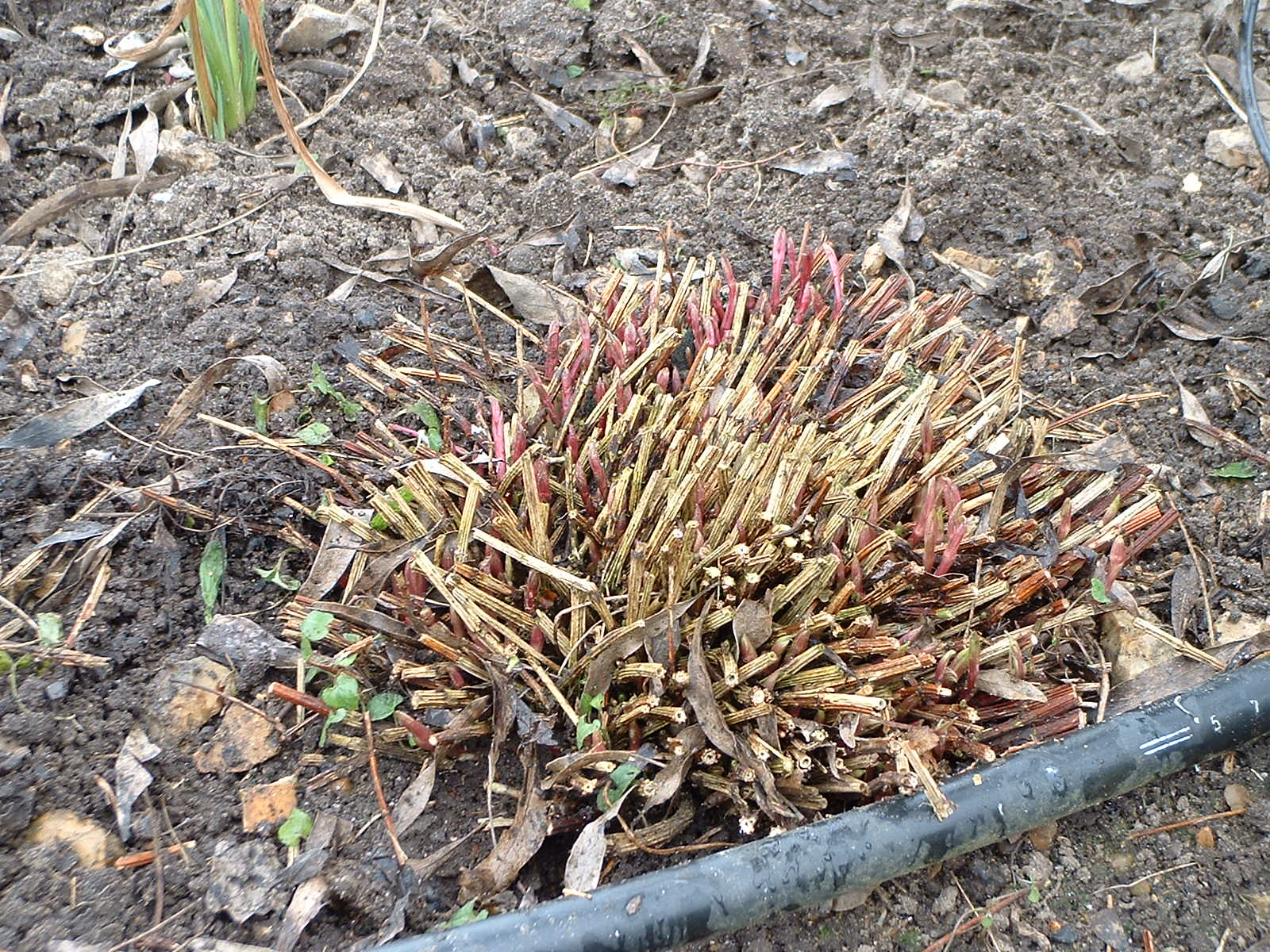
Your herbaceous clematis can be pruned just like other herbaceous plants in the garden, however do not hard prune the Heracleifolia Group until April when the weather has improved as they over-winter much better with their old growth left intact.
Completely dead stems on some herbaceous clematis such as the Integrifolia and Diversifolia Groups can be cut to 3” (8cm) in February to March, take care to avoid nipping off the new shoots as they are emerging from the ground!
To the right is a picture of an integrifolia which has been pruned, although it could easily be mistaken for a hedgehog at first glance..!
Pruning Made Easy. (A blog article written Winter 2018)
Pruning is one of my favourite jobs in the garden, I love to get secateurs, or better still, loppers, in hand, especially when a good tidy up becomes essential! Late February is a good time to prune the majority of our clematis – those that need either a light or a hard prune (pruning groups 2 and 3 if you prefer to work in numbers).
Hard pruning is dead easy, it is relatively quick, not too many decisions have to be made and it is excellent therapy for a day when you maybe have ‘got out of bed on the wrong side’! Whereas light pruning requires some decisions regarding height, shape etc., it is fiddlier and therefore requires doing on a day when all is well with your world and patience is plentiful!
I will keep this as clear and simple as possible
Lets deal with hard pruning (group 3) first – this group includes all the Late Large Flowered Hybrids, the Viticella, Integrifolia, Texensis, Flammula, Florida, Recta, Tangutica, Diversifolia and Heracleifolia Groups.
The hard pruning will vary, very slightly, between the groups – we will start with the Late Large Flowered and Viticellas first as the technique is exactly the same for both groups.
Start at soil level and track up each stem looking for a good set of viable buds in the leaf joints, leave two sets of buds and prune off just above the second set – this will be anywhere between 9” and 18” above the soil.
Try to leave two good sets of buds as insurance because the top set will shoot away quickly once the weather warms up and could get ‘nipped’ by a late hard frost. If this does happen, don’t worry, the lower set of buds will have remained dormant so you can prune any damaged growth down to them and all will be well.
Having pruned through all the stems all you need to do now is gather the rubbish stems together and pull them away from their support – this is the best bit!
Clematis in the Integrifolia, Diversifolia, Flammula, Recta and Texensis groups usually die down each winter, often to soil level and therefore need treating slightly differently at pruning time.
Again start at soil level, if there are viable buds along the stems, prune as previously described. If there aren’t, simply prune off about 3” above the soil – there will be new shoots at, or just below soil level which will quickly make new growth to provide this year’s blooms.
Integrifolia Alba pruned..jpg)
Varieties in the Tangutica group are unlikely to have any visible signs of viable buds and should therefore be pruned straight through about 18” above the soil – garden shears are useful here which saves time! The plant will look dead for weeks but will suddenly burst into new growth as the weather warms up.
Clematis in the Heracleifolia group should only have their old flowering wood ‘topped’ just now – you to prune them later in the spring, early April is ideal. See the Pruning Heracleifolias and Winter Flowering Clems. blog for instructions but for now, simply reduce the stem by half, this will help to tidy the garden up.
Clematis in the Florida group are not 100% hardy, but if you are fortunate to live in a milder area, or if you have a very sheltered garden then maybe you have these planted out. Most of us however, have to rely on growing these exotic beauties in pots so that we can move them into a greenhouse or conservatory to overwinter. Whichever, you may find that the plant has remained semi-evergreen, or even still in flower – but you must prune it now! Simply prune off above a set of buds or leaf joints around 12” above the soil.
If you simply do not have the time, or even the patience to sort out your different varieties of hard pruning types you could just gather the stems together, prune through about 12 – 18” above the soil and remove the top-growth – that would be sufficient to tidy the plant and it would still be fine!
Light pruning is for your Early Large Flowered Group –
These clematis often make a large ‘ball’ of growth at the top of the plant that I refer to as “the birds nest”! The easiest way to deal with these clematis is to roughly cut off the top 1/3 of the stems in mid-February (St. Valentines Day maybe!) Return after a couple of weeks once new shoots have started to appear.
This time, start at the top of the plant and track down each stem pruning off dead growth just above the first viable set of buds in the leaf joints. The height at which these buds appear will vary and you may find some stems with no viable buds until low down near the soil. Don’t worry, this is quite normal, prune these stems just above the low buds then very carefully remove the cut stem from amongst the ‘good’ ones. It will be worth the effort as this method will ensure new fresh growth is made from top to bottom of the plant, in turn this will encourage flowering up and down the plant.
Keep in mind that clematis are tolerant of most things the gardener does to them and I do not know of an instance where a clematis has died simply because it has been pruned incorrectly!
.jpg)
Light prune completed
Tips: - Now is the time to feed all your clematis a single handful of bonemeal. Scatter it around the base of the plant and carefully work it into the soil, but do avoid knocking off any freshly emerging shoots. If rain is not expected within a day or two, water it in. Bonemeal (not Fish, Blood and Bone) will give a good slow start to your clematis.
You can also add some slow release fertiliser tablets to those clematis that are hard to get to, for example at the back of the border, this saves you having to scramble around the borders to feed them through the summer.
I hope this helps you get through the pruning of your clematis more easily and if it makes you feel better about it, before you start, just tell them, ‘Peter said so!’

